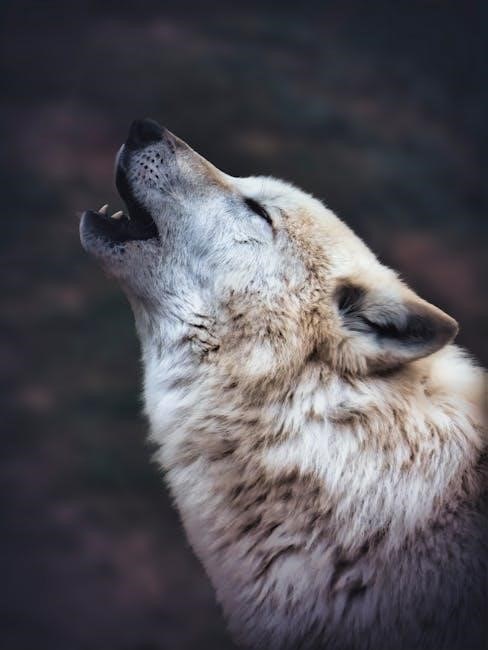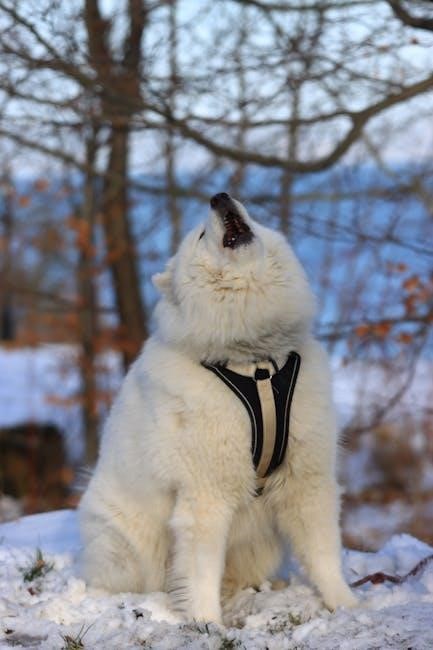Overview of Pathfinder: Howl of the Wild
Pathfinder: Howl of the Wild is a 224-page rulebook focused on wilderness exploration, introducing new ancestries, character options, and creatures․ It enhances both player and GM experiences with nature-themed content, perfect for deepening immersion in the wilds of Golarion․
Pathfinder: Howl of the Wild is a comprehensive guide designed to immerse players and Game Masters in the untamed beauty and dangers of the wilderness․ This 224-page sourcebook introduces a wealth of new content, including six playable ancestries, enhanced character options, and detailed rules for wilderness exploration․ It focuses on nature-themed mechanics, offering tools to create immersive encounters and customize creatures for specific environments․ The book also delves into the lore of Golarion’s wilds, providing inspiration for adventurers and storytellers alike․ Whether you’re a player seeking to connect with nature or a GM aiming to craft compelling outdoor adventures, Howl of the Wild is an essential addition to your Pathfinder 2E collection․
1;2 Focus on Wilderness and Nature
Pathfinder: Howl of the Wild places a strong emphasis on immersing players and Game Masters in the untamed wilderness․ The sourcebook introduces detailed mechanics for survival, exploration, and navigating the challenges of nature․ It explores the interconnectedness of flora and fauna, offering regional variants of monsters and new creatures that inhabit diverse ecosystems․ Environmental hazards, such as extreme weather and treacherous terrain, are also highlighted, providing players with dynamic challenges․ Additionally, the book enhances the role of animal companions, allowing them to be more integrated into both storytelling and gameplay․ This focus on nature creates a richer, more immersive experience for outdoor adventures in the world of Golarion․
1․3 Relevance for Players and Game Masters
Pathfinder: Howl of the Wild offers immense value for both players and Game Masters, enriching their experiences with nature-themed content․ Players gain access to new ancestries, archetypes, and class feats, allowing for unique character builds that thrive in wilderness settings․ Meanwhile, Game Masters are equipped with tools to craft engaging outdoor encounters, customize monsters, and incorporate environmental challenges․ The book’s focus on animal companions and familiars adds depth to party dynamics, while its exploration mechanics provide structure for overland adventures․ Whether you’re a player seeking to embody a wild soul or a GM aiming to create immersive outdoor campaigns, Howl of the Wild delivers a wealth of opportunities to enhance your Pathfinder 2E experience․

New Ancestries in Howl of the Wild
Howl of the Wild introduces six new ancestries, each with distinct lore and mechanics, adding diversity to character creation in Pathfinder 2E, including centaurs, minotaurs, awakened animals, merfolk, insectiods, and atamaru, each offering unique playstyles and backgrounds․
2․1 Centaurs: Lore and Mechanics
Centaurs in Howl of the Wild are wise, nomadic beings with a deep connection to nature, blending human and equine traits․ Their lore emphasizes harmony with the wild, making them excellent druids or rangers․ Mechanically, centaurs gain bonuses to Strength and Dexterity, reflecting their physical prowess and agility․ Unique abilities like Natural Runner enhance their movement in the wilderness, while Skilled boosts their proficiency in key survival skills․ These traits make centaurs versatile characters, ideal for parties focused on exploration and nature-based builds․ Their inclusion in Howl of the Wild enriches the game’s wilderness theme and offers players fresh, unique playstyles;

2․2 Minotaurs: Background and Traits
Minotaurs in Howl of the Wild are ancient, powerful beings with a mysterious connection to labyrinths and the wild․ Their lore often ties them to forgotten civilizations, emphasizing strength and resilience․ Mechanically, minotaurs possess impressive physical prowess, with bonuses to Strength and Constitution․ Unique traits like Labyrinthine Insight grant them expertise in navigation and perception, while Unstoppable Charge allows devastating attacks in combat․ These abilities make minotaurs ideal for barbarians or fighters, offering a blend of brute force and strategic thinking․ Their inclusion in the book adds depth to wilderness-themed campaigns, providing players with a rugged, enigmatic ancestry to explore․
2․3 Awakened Animals: Unique Playable Ancestry
Awakened Animals are a groundbreaking ancestry in Howl of the Wild, offering players the chance to embody intelligent, humanoid versions of beasts․ This ancestry allows for a wide range of customization, from foxes to wolves, each with unique abilities tied to their animal kin․ Players can choose from various species, each granting distinct traits such as keen senses or natural weapons․ The mechanics emphasize adaptability, with bonuses to Dexterity and Wisdom, reflecting their wild instincts․ Story-wise, Awakened Animals often serve as bridges between nature and civilization, bringing a fresh perspective to parties․ This ancestry enriches the game with diverse character builds and narrative possibilities, making it a standout feature of the book․
2․4 Merfolk: Adaptation to Land and Water
Merfolk in Howl of the Wild are a versatile ancestry, excelling in both aquatic and terrestrial environments․ They possess natural swimming proficiency and enhanced breath-holding abilities, making them ideal for underwater adventures․ On land, they adapt gracefully, with bonuses to Dexterity and Constitution, reflecting their resilience and agility․ Merfolk also gain access to spells tied to water and aquatic themes, deepening their connection to marine environments․ Their cultural background often ties them to the mysteries of the deep, offering rich narrative hooks for players․ This ancestry provides a unique blend of adaptability and specialization, allowing characters to thrive in diverse settings while maintaining a strong connection to their aquatic heritage․
2․5 Insectiods: A New Insect-Based Ancestry
Insectiods are a fascinating new ancestry introduced in Howl of the Wild, blending human and insect traits․ They feature chitinous exoskeletons, granting natural armor, and compound eyes that enhance low-light vision․ Insectiods also possess unique abilities such as Phonoreception, allowing them to detect vibrations and movements with uncanny accuracy․ Their connection to nature grants them proficiency in Survival and bonuses to Perception․ Culturally, Insectiods often live in colonies, valuing community and teamwork․ Players can choose from various sub-ancestries, each mimicking different insect traits, offering diverse playstyles․ This ancestry adds a fresh layer of versatility and thematic depth, making them a compelling choice for nature-focused characters in Pathfinder campaigns․
2․6 Atamaru: The Return of the Locathah
Atamaru brings back the Locathah ancestry, now reimagined with aquatic and terrestrial adaptability․ These humanoid fishfolk thrive in water but also navigate land with surprising agility․ Their gills allow underwater breathing, while their webbed hands enhance swimming․ Atamaru possess natural armor from their scales and a bite attack for close combat․ Culturally, they are deeply connected to nature and often serve as guardians of aquatic realms․ The Zunar’s Blessing ability grants them resistance to environmental effects, making them resilient in both water and land․ This ancestry offers a unique blend of aquatic prowess and terrestrial versatility, appealing to players seeking a nature-focused, adaptable character․ Their return enriches Pathfinder’s racial diversity with a timeless aquatic classic․
Character Options and Enhancements
Howl of the Wild introduces archetypes, class feats, and spells that emphasize nature and survival․ These options empower characters to thrive in wilderness settings, enhancing both combat and exploration․
3․1 Archetypes Focused on Wilderness
Howl of the Wild introduces wilderness-focused archetypes, offering unique playstyles tied to nature and survival․ These archetypes provide characters with abilities like enhanced tracking, survival skills, and elemental resistances, allowing them to thrive in harsh environments․ Players can choose archetypes such as the Wild Drake or others, each with distinct mechanics that emphasize connection to the wild․ These options enhance exploration and combat, making characters more versatile in outdoor settings․ The archetypes are designed to integrate seamlessly with existing classes, providing fresh ways to engage with the game world․ GMs also benefit from these archetypes, as they offer new narrative hooks and encounters tailored to wilderness adventures․
3․2 Class Feats for Nature-Themed Builds
Howl of the Wild expands character customization with class feats tailored for nature-themed builds․ These feats allow characters to harness the power of the wild, granting abilities like summoning animal allies or manipulating weather․ For example, druids can enhance their elemental spells, while rangers gain improved tracking and survival skills․ Fighters and rogues also benefit with feats that boost endurance and stealth in outdoor environments․ These feats are designed to enhance gameplay, offering players new strategies for wilderness adventures․ The mechanics are balanced to ensure seamless integration with existing class features, providing a fresh layer of depth for nature-focused characters․ This section is a must for players aiming to create unique, wilderness-attuned characters in Pathfinder 2E․

3․3 Spells and Abilities Tied to the Wild
Howl of the Wild introduces a variety of spells and abilities that deepen a character’s connection to nature․ These include summoning animal allies, manipulating weather conditions, and enhancing survival skills․ Druids and rangers gain access to powerful elemental spells, while other classes unlock unique wild-themed abilities․ The book also expands on existing magic systems, allowing players to craft nature-infused spells that interact with the environment․ Abilities like terrain adaptation and sensory enhancements further immerse characters in the wilderness; These additions enrich character builds, offering creative ways to interact with the wild and solve challenges․ The section provides balanced mechanics, ensuring these abilities are both fun and functional in gameplay․

Creatures and Monsters in the Wild
Pathfinder: Howl of the Wild expands the game with diverse creatures, regional monster variants, and enhanced animal companions, offering fresh challenges and encounters in the wilderness․

4․1 Regional Variants of Existing Monsters
Howl of the Wild introduces regional variants of existing monsters, adapting creatures to specific environments․ These variants add depth and challenge, making encounters feel fresh and dynamic․ For example, a wolf might have forest and tundra variants with unique abilities․ This approach enhances immersion, allowing monsters to thrive in their natural habitats․ Players and GMs alike benefit from these tailored threats, creating more engaging and thematic combat experiences․ The book ensures each variant feels distinct, offering new strategies and surprises for adventurers․ This feature enriches the game world, making exploration and battle more unpredictable and exciting․
4․2 New Creatures Introduced in the Book
Howl of the Wild expands the Pathfinder universe with a variety of new creatures, each deeply tied to the wilderness theme․ These additions include unique beasts, mysterious fey, and fearsome predators, all designed to enhance the wilds of Golarion․ Each creature is meticulously detailed, offering fresh challenges and storytelling opportunities for GMs․ From towering forest guardians to cunning swamp dwellers, these new entries diversify encounters and enrich the game world․ Players will encounter these creatures in diverse environments, each with unique abilities and ecological roles․ This section ensures that the wilderness feels alive and unpredictable, providing endless inspiration for both players and Game Masters․

4․3 Animal Companions and Their Roles

Howl of the Wild introduces enhanced rules and options for animal companions, making them more integral to the game․ Players can now customize their companions with unique abilities and traits, allowing for deeper integration into party dynamics․ These companions are not just pets but vital allies, capable of aiding in exploration, combat, and problem-solving․ The book provides detailed mechanics for their growth and interaction, ensuring they feel like living, breathing members of the adventuring group․ This section also explores how companions adapt to different environments, emphasizing their role as both loyal friends and strategic assets․ These improvements elevate animal companions from sidekicks to central elements of a character’s identity and story․

Wilderness Exploration Mechanics
Howl of the Wild introduces robust mechanics for survival, exploration, and navigation, enhancing immersion in Pathfinder’s wilds․ Players and GMs gain tools to create dynamic, immersive encounters and challenges․
5․1 Survival and Exploration Rules
Howl of the Wild introduces comprehensive survival and exploration mechanics, allowing players to immerse themselves in the untamed wilderness․ The book provides detailed rules for managing resources, navigating diverse terrains, and overcoming environmental challenges․ Players can engage in activities like foraging, tracking, and shelter-building, adding depth to outdoor adventures․ These mechanics enhance the sense of immersion, making every journey through the wild feel dynamic and unpredictable․ GMs also gain tools to craft compelling encounters, ensuring that exploration is as engaging as combat․ The rules encourage strategic thinking and creativity, rewarding players for adapting to their surroundings․ This section transforms wilderness exploration into a core gameplay experience, rich with opportunities for storytelling and skill-based challenges․
5․2 Navigation and Tracking Mechanics
Howl of the Wild introduces robust navigation and tracking mechanics, enabling players to master the art of traversing uncharted territories․ The book details how to use skills like Survival, Nature, and Perception to identify landmarks, follow trails, and avoid hazards․ Tracking mechanics allow characters to pursue or avoid creatures, with modifiers based on terrain and conditions․ These rules add realism and depth to exploration, making every journey feel immersive․ GMs can create dynamic encounters by leveraging these mechanics, ensuring that navigation is both challenging and rewarding․ Players will need to adapt their strategies based on the environment, making navigation a core part of the adventure experience․
5․3 Environmental Hazards and Challenges
Howl of the Wild expands on environmental hazards, offering detailed rules for navigating treacherous terrains and weather conditions․ Players must contend with avalanches, quicksand, and extreme temperatures, each with unique mechanics․ The book introduces dynamic weather systems that impact gameplay, from blizzards reducing visibility to thunderstorms causing electrical hazards․ Additionally, hazards like raging rivers and unstable caves require skill checks to overcome․ These challenges enhance immersion, forcing players to adapt their strategies․ GMs can use these tools to create memorable encounters, ensuring that the wilderness feels alive and dangerous․ The rules provide a balanced mix of risk and reward, making survival a core aspect of the game․
Animal Companions and Familiars
Howl of the Wild introduces new options for animal companions, enhanced familiar rules, and tools to integrate them into your game seamlessly, enriching both storytelling and gameplay․
6․1 New Options for Animal Companions
Howl of the Wild expands the role of animal companions with new feats, archetypes, and customization options․ These enhancements allow players to tailor their companions’ abilities, making them more versatile in both exploration and combat․ The book introduces unique traits and skills, enabling companions to adapt to diverse environments and challenges․ Additionally, new bonding mechanics deepen the relationship between adventurers and their animal allies, adding emotional depth to the game․ These options ensure that animal companions are not just pets but integral members of the party, capable of contributing meaningfully to the story and gameplay․ This section is a must for anyone looking to elevate their animal companion’s role in Pathfinder 2E․
6․2 Enhanced Familiar Rules
Howl of the Wild introduces enhanced rules for familiars, offering greater versatility and customization․ Players can now unlock new abilities and spells tailored to their familiar’s nature, allowing for deeper strategic integration in combat and exploration․ The book provides expanded options for bonding with familiars, enabling unique interactions and shared abilities․ These enhancements make familiars more than just magical companions—they become integral allies with distinct personalities and capabilities․ The rules also include new ways to protect and enhance familiars, ensuring they remain valuable assets throughout a character’s journey․ This section is a treasure trove for spellcasters seeking to maximize their familiar’s potential in both utility and combat scenarios․
6․3 Integrating Companions into the Game
Howl of the Wild provides comprehensive tools for integrating animal companions and familiars into your Pathfinder 2E campaigns․ The book offers detailed guidelines for GMs to craft unique interactions, encounters, and story hooks that involve companions․ Players will find new ways to bond with their companions, enhancing their roles in both combat and exploration․ The rules also include tips for managing companion growth and ensuring they remain balanced yet impactful․ These enhancements allow companions to feel like true members of the party, with their own personalities and contributions․ The section emphasizes creating emotional bonds and shared adventures, making companions an integral part of the storytelling experience․
Tools for Game Masters
Howl of the Wild equips GMs with resources to craft immersive wilderness adventures, including encounter-building guides, environmental challenge mechanics, and tips for adapting monsters to natural settings․
7․1 Creating Wilderness Encounters
Howl of the Wild provides GMs with comprehensive tools to craft dynamic wilderness encounters, blending regional monster variants with environmental hazards․ The book offers detailed guides for designing encounters that reflect diverse ecosystems, from dense forests to snow-capped mountains․ GMs can customize monsters to fit specific terrains, ensuring each encounter feels unique and immersive․ Additionally, the rulebook includes mechanics for survival challenges, such as extreme weather and navigation, allowing GMs to create layered, realistic scenarios․ These tools empower GMs to weave compelling stories that highlight the beauty and danger of the wild, keeping players engaged and invested in their adventures․
7․2 Customizing Monsters for the Environment
Howl of the Wild equips Game Masters with robust tools to adapt monsters to specific environments, enhancing encounter diversity․ The book provides regional variants for classic creatures, allowing GMs to tailor monsters to forests, deserts, or tundras․ These adjustments include thematic abilities and traits that reflect the creature’s habitat, making encounters feel more authentic․ For example, a forest-dwelling monster might gain camouflage abilities, while a desert variant could develop heat resistance․ The rulebook also offers guidance on modifying stats and behaviors to suit the environment, ensuring each creature feels like a natural part of its ecosystem․ This customization enhances immersion, challenging players in unique and memorable ways․
7․3 GM Resources and Tools

Howl of the Wild provides an array of resources for Game Masters, designed to enhance wilderness adventures․ The book includes encounter tables, environmental effects, and dynamic event systems, allowing GMs to craft immersive scenarios․ Tools for creating custom terrain hazards and weather events add depth to outdoor settings․ Additionally, the rulebook offers tips for balancing encounters in remote areas and integrating nature-themed NPCs․ These resources empower GMs to create engaging, dynamic, and memorable wilderness experiences, ensuring every adventure feels unique and connected to the natural world․ The tools are flexible, catering to both new and experienced GMs, and are seamlessly integrated with the game’s existing mechanics․
Pathfinder: Howl of the Wild is an essential resource for nature-themed campaigns, offering rich content for players and GMs․ Its comprehensive tools and vibrant wilderness focus make it a must-have for enhancing your Pathfinder 2E experience․
8․1 Summary of Key Features
Pathfinder: Howl of the Wild is a 224-page rulebook designed to deepen immersion in nature-themed campaigns․ It introduces six new ancestries, including Centaurs, Minotaurs, Awakened Animals, Merfolk, Insectiods, and Atamaru, each with unique lore and mechanics․ The book expands character options with wilderness-focused archetypes, class feats, and spells tied to the wild․ It also features regional monster variants, new creatures, and enhanced rules for animal companions and familiars․ Wilderness exploration is enriched with survival, navigation, and environmental hazard mechanics․ GMs gain tools for creating encounters, customizing monsters, and managing the wild․ This comprehensive resource is a must-have for players and GMs seeking to explore Golarion’s untamed frontier․
8․2 Impact on the Pathfinder 2E Community
Pathfinder: Howl of the Wild has significantly enriched the Pathfinder 2E community by offering diverse new content․ Its introduction of six unique ancestries and wilderness-themed mechanics has expanded character creation possibilities, appealing to both veterans and newcomers․ Players and GMs alike benefit from enhanced exploration and combat options, fostering deeper immersion in nature-based campaigns․ The book’s focus on environmental storytelling and creature customization has inspired community-created content and homebrew expansions․ Its release has revitalized interest in outdoor adventures, making it a cornerstone resource for anyone exploring Golarion’s wilds; This supplement has set a new standard for thematic depth in Pathfinder 2E, ensuring its influence for years to come․
8․3 Where to Get the Howl of the Wild PDF
The Howl of the Wild PDF is available for purchase on platforms like Roll20 and Paizo’s official website․ It can also be found on online retailers such as Amazon․ The digital version is fully integrated with Roll20, offering interactive features for online play․ This PDF is a must-have for fans of nature-themed adventures, providing detailed rules, ancestries, and creatures․ Its release has made it easier than ever for players and GMs to access wilderness-focused content․ Whether for home games or online sessions, the PDF ensures seamless gameplay and inspiration for exploring Golarion’s untamed regions․ It’s a valuable resource for enhancing any Pathfinder 2E campaign․
